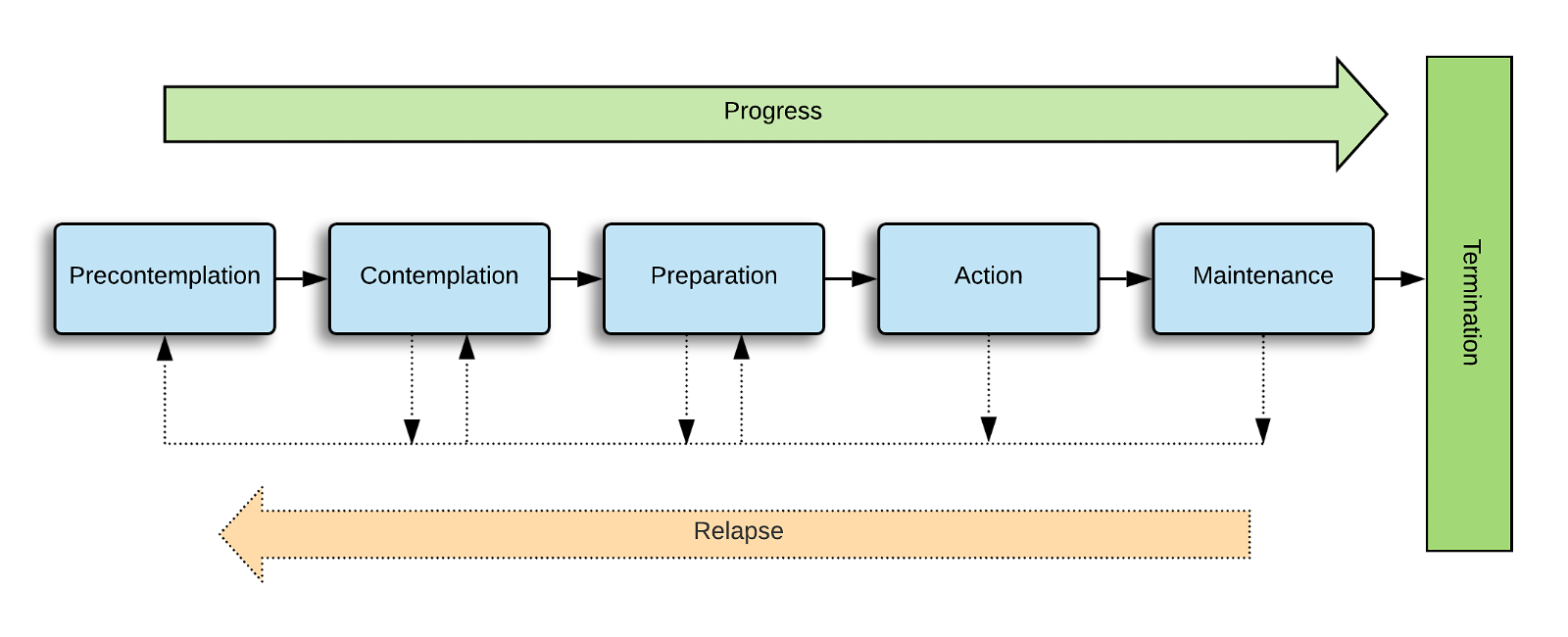The 6 Stages of Change: Worksheets for Helping Your Clients
 It was Dean Karnazes’s 30th birthday, and he felt trapped. Despite a successful career and a happy marriage, he was lost and disillusioned.
It was Dean Karnazes’s 30th birthday, and he felt trapped. Despite a successful career and a happy marriage, he was lost and disillusioned.
That evening, he was drunk and out with friends at a night club in San Francisco when a beautiful young woman approached him. They hit it off instantly. One way or another, what he decided next would determine his future.
Perhaps unexpectedly, he made his excuses and left. Once home, he rooted through boxes, took out an old pair of sneakers, and did something he hadn’t done since college: he started running (Karnazes, 2006).
And he carried on, and on, becoming famous for winning several ultra-marathons and running across America. He has since been named as one of the “Top 100 Most Influential People in the World” by Time magazine.
Change can take many forms. Sometimes we choose it, and sometimes it just happens.
The Transtheoretical Model of Change explains the stages we pass through when we change our behavior and provides the insights we need to intervene and move on in life.
In this article, we look at the model, explore the stages and multiple factors involved in change, and identify worksheets that can help you or your client.
Before you continue, we thought you might like to download our three Goal Achievement Exercises for free. These detailed, science-based exercises will help you or your clients create actionable goals and master techniques to create lasting behavior change.
This Article Contains:
- What Are the Stages of Change?
- Stage 1: Precontemplation
- Stage 2: Contemplation
- Stage 3: Preparation
- Stage 4: Action
- Stage 5: Maintenance
- Stage 6: Relapse
- Stage 7: Termination
- 5 Worksheets to Aid Your Clients’ Process
- 4 Ways to Use Motivational Interviewing
- PositivePsychology.com Resources
- A Take-Home Message
- References
What Are the Stages of Change?
The Transtheoretical Model of Change (TTM) – the result of the analysis of more than 300 psychotherapy theories – was initially developed in 1977 by James Prochaska of the University of Rhode Island and Carlo Di Clemente (Prochaska & Velicer, 1997).
The TTM offers a theory of healthy behavior adoption and its progression through six different stages of change: precontemplation, contemplation, preparation, action, maintenance, and termination.
TTM is a model, rather than a single method for change, combining four key constructs and a temporal dimension – not present in other theories at that time – that can help a client understand behavioral transformation.
- Stages of change
Each of the six stages must be completed in order to implement behavioral change into a client’s lifestyle. - Processes of change
Ten processes capture the critical mechanisms for driving change. - Critical markers of change
Beliefs and confidence develop as a client moves through the stages. - Context of change
Factors such as risk, resources, and obstacles provide context and influence change.
How do we progress through change?
Our perception of change – for example, altering our diet or increasing exercise –transforms over time. In earlier stages, we see more cons than pros, but over time, in later stages, the balance shifts, and we start to see increased benefits to behavioral change.
The model helps us understand not only the process by which clients make an intentional change, but also the support from themselves and others that can help. As such, it provides a useful tool for therapists, counselors, and health professionals working with clients and patients.
TTM identifies six stages of readiness experienced by an individual attempting to change (Prochaska & Velicer, 1997; Liu, Kueh, Arifin, Kim, & Kuan, 2018):
- Precontemplation – failing to recognize the need for change
- Contemplation – seriously considering the need for change
- Preparation – making small changes
- Action – exercising for less than six months
- Maintenance – regular exercise lasting longer than six months
- Termination
The final stage, termination, is perhaps more of a destination – an end state. At this point, even if bored or depressed, the client will not return to their former way of coping (Prochaska & Velicer, 1997).
However, it is essential to note that the client’s behavior through earlier stages may not be linear. Instead, it occurs in cycles; they may revisit – or relapse – to prior stages before moving on to the next.
An individual may maintain their diet for months, but then on vacation, return to their old ways. After several weeks, they may start re-considering returning to their new diet or seek out other options.
What influences change?
Many factors impact – strengthening or weakening – the client’s ability to change.
TTM lists 10 processes that assist the progression between these stages; important ones include self-efficacy, decisional balance, and temptations.
Indeed, self-efficacy – the belief in our ability to change – is crucial to planning and executing the actions required to meet the goals we set and fight the temptation to relapse (Luszczynska, Diehl, Gutiérrez-Dona, Kuusinen, & Schwarzer, 2004).
As a result, clients high in self-efficacy are better at accepting challenges and persisting in overcoming obstacles.
The individual’s perception of the positive and negative aspects of modifying their behavior is also crucial to success. They must balance the pros and cons to decide whether to continue the journey, fall back, or give in.
Successful change requires the client to believe that the benefits outweigh the drawbacks.
But there is help at hand.
Indeed, interventions based on the TTM have resulted in substantial improvements when applied across multiple disciplines, including the workplace and health settings (Liu et al., 2018; Freitas et al., 2020).
Next, we review the six stages of change to understand what it means to be in each, its goal, and the tasks that, when completed, help a person move to the next (guided by Prochaska & Velicer, 1997).
Stage 1: Precontemplation
“I don’t need to change.”
Client status
Change is not wanted, needed, or possible.
Client goal
Seriously consider the need for behavioral change.
Description
The Precontemplation stage occurs when the client has no intention, now, or in the future (typically seen as six months), to change their behavior.
For example, “I have no intention of taking up a sport or going running.”
Most likely, they are either under-informed or uninformed.
The client is either completely unaware or lacking details regarding the health benefits of changing their behavior and taking up physical exercise.
Perhaps they tried previously, with little apparent success, and have become demoralized or despondent.
Tasks
- Increase client awareness of why change is needed.
- Discuss the risks regarding their current behavior.
- Get the client to consider the possibility of change.
Stage 2: Contemplation
“I might change.”
Client status
Procrastination. The client intends to make the change within six months.
Client goal
Commit to change in the immediate future.
Description
The client has become acutely aware of the pros of making the change, but they are also keenly aware of the cons.
For example, “I know I need to lose weight for my health, but I enjoy fast food.”
Balancing the costs versus the benefits can lead to ambivalence – mixed and contradictory feelings – that cause the client to become stuck, often for an extended period.
Tasks
- Consider the pros and cons of existing behavior.
- Weigh up the pros and cons of the new behavior.
- Identify obstacles to change.
Stage 3: Preparation
“I will change. Really!!”
Client status
Committed to changing their behavior.
Client goal
Develop an action plan to organize resources and develop strategies to make the changes happen.
Description
The client intends to move to the action stage soon – typically within the next month – but they are not there yet.
For example, “I need to understand what support is available and put it in place before I stop smoking.”
The client typically begins to put actions in place, for example, starting a gym membership, joining a class, or engaging with a personal trainer.
Tasks
- Increase the client’s commitment.
- Write down the client’s goals.
- Develop a change plan.
Stage 4: Action
“I have started to change.”
Client status
The plan has taken effect, actions are underway, and a new pattern of behavior is forming.
Client goal
The new behavioral pattern has remained in place for a reasonable length of time (typically six months).
Description
The client has made good progress; they have modified their lifestyle over the last six months.
For example, “I go to the gym on Mondays, Wednesdays, and Fridays every week, and I am following a plan set out by my trainer.”
Their new behavior is observable by other people, whether it’s exercising, eating more healthily, or no longer smoking.
Tasks
- Implement the plan.
- Revisit and revise the plan if needed.
- Overcome difficulties and maintain the commitment.
- Reward successes.
Stage 5: Maintenance
“I’ve changed.”
Client status
A new pattern of behavior has been sustained for a reasonable amount of time and is now part of the client’s lifestyle.
Client goal
Sustain the new behavior for the long term.
Description
Within the maintenance stage, the client becomes confident they can continue their new lifestyle, and the behavioral change is embedded in their lives. Perhaps equally important, they are less likely to relapse – to fall or slip back into their old selves.
For example, “I am confident I can make healthy eating choices at home, work, or when I go out.”
Based on data from both self-efficacy and temptation studies, maintenance can last between six months and five years (Prochaska & Velicer, 1997).
Tasks
- Maintain behavior across multiple situations.
- Continue integration into life.
- Develop coping strategies.
- Avoid regression or relapse into old ways.
Stage 6: Relapse
“I’ve returned to my old ways.”
Client status
Returned to an earlier stage.
Client goal
Reaffirm commitment and begin progressing through each stage again.
Description
A relapse is a form of regression to an earlier stage. It is not a stage in itself, but a failure to maintain the existing position in behavioral change, either as a result of inaction (e.g., stopping physical activity) or the wrong activity (e.g., beginning smoking again.)
Unfortunately, relapse is typical for many health-related behavioral changes. But it is not inevitable.
For example, “I was out the other night and started smoking. I’ve continued since.”
The smoker begins smoking, the new runner gives up, the diet is over, fast food is back on the menu.
Tasks
- Identify the triggers linked to relapse.
- Reaffirm commitment to change.
- Revisit the tasks associated with the stage the client has returned to.
Stage 7: Termination
“ I am changed forever.”
Client status
The temptation to return to old ways of behavior is no longer present.
Client goal
None required; behavioral change is part of who the client is.
Description
Success. The client has zero temptation, and their self-efficacy is 100%.
They will not return to their old ways, for example, if they argue with their partner, are unhappy with work, or dent their car. The unhealthy habit is no longer a part of their way of coping.
Instead, the new behavior is part of the person’s identity and lifestyle and has persisted for a long time.
For example, “I have been keeping up with physical exercise for some years now, and even after recovering from a long-term injury, I continue to do so.”
Tasks
- None required. The client’s old ways are in the past.
Note that an alternative view is that termination is never reached. There is always a risk of relapse into prior unhealthy ways, even several years down the line. In this picture, the individual only ever remains in the maintenance stage.
Transtheoretical model and stages of change – Practical Psychology
5 Worksheets to Aid Your Clients’ Process
The following worksheets support the client in planning, implementing, and maintaining behavioral change:
The five A model
The five A framework was created to help smoking cessation but has since been successful in the management of other negative health habits (e.g., excessive drinking, lack of exercise, and substance abuse).
| 5 As | Instruction |
|---|---|
| Ask | Use a simple question to collect and analyze information about the client,
e.g., identify tobacco use. |
| Advise | Identify the behavioral change required and suggest that the client make that change,
e.g., recommend the smoker considers stopping. |
| Agree | Determine the stage of change the client is in,
e.g., is the smoker prepared to attempt to stop? |
| Assist | Assistance needs to be appropriate to the stage the client is in,
e.g., use counseling, training, or pharmacotherapy to help them quit. |
| Arrange | Arrange activities inside and outside of consultation,
e.g., schedule follow-up appointments, refer them to another resource, and monitor change. |
Decisional Balance Worksheets
Changes are most effective when there is motivation and ‘buy-in’ from the client.
The Decisional Balance Worksheet provides an excellent way of capturing pros versus cons involving a change under discussion.
Stages of Change
The Stages of Change worksheet is a free download to educate the client about the stages involved in behavioral transformation and relapse.
Relapse Prevention Plan
The Relapse Prevention Plan provides a useful resource to capture coping skills and social support, along with the potential impact of relapse in behavior.
Goal Setting
Goal Setting is crucial to any transformation. It provides focus, tracks progress, and ensures appropriate support and resources are in place for success.
Our SMART Goals Worksheet offers a valuable tool for defining and documenting realistic, achievable, and time-bound goals.
4 Ways to Use Motivational Interviewing

The approach has proven successful as an intervention for managing health conditions and overcoming addiction.
The OARS acronym offers guidance for a set of basic questions to be used early and on an ongoing basic in an interview:
Open questions
Invite someone to tell their story, without leading or directing them.
How can I help you with… ?
What have you tried before to make a change?
Affirmations
Acknowledge someone’s strengths and behaviors that lead to positive change.
That’s a great idea.
I’ve enjoyed talking with you today.
Reflective listening
Listening well is essential to building trust, engagement, and developing the motivation required to change.
Focus on the real message being spoken by repeating or rephrasing what has been said.
So you feel that…
Are you wondering whether…?
Summaries
This is a particular way of using reflective listening, often at the end of discussing a topic or when the interview is about to finish.
So, from what I understand so far …
This is what I’ve heard; please let me know if I’ve missed anything.
The answers to the above questions feed into the process of planning with the client.
PositivePsychology.com Resources
The following resources will help your client progress through the six stages, reducing the likelihood of relapse.
Basic needs satisfaction
Meeting basic psychological needs can help the client avoid becoming stuck and unable to proceed with positive behavioral changes.
WDEP questions worksheet
Use this list of questions to help a client understand what they Want, what they are Doing, Evaluate if it is working, and follow their Plan to change things for the better.
Abstraction worksheet
Download and complete this worksheet to identify the behavior to be changed, understand the steps to get there, and visualize how it will look.
Self-Directed Speech Worksheet
Use the client’s inner voice to motivate them to make changes in their life, with this Self-Directed Speech Worksheet.
Reward Replacement Worksheet
Identify and document the rewards that will arise from a change in behavior to motivate the client.
Behavior Contract
Helping the client write a Behavior Contract for the changes they wish to make can be an effective way of forming a commitment.
If-Then Planning
We often fail to act on our good intentions. If-Then planning can offer an effective strategy to turn goals into action.
Self-validation and Self-respect
Self-efficacy can grow over time as a result of a cycle of achievement and building confidence. This tool helps the client enhance their self-confidence.
Breaking out of the Comfort Zone
Growth mindsets must be translated into action, usually outside of the comfort zone. This tool helps the client identify opportunities to challenge their comfort zone.
17 Motivation & Goal-Achievement Exercises
If you’re looking for more science-based ways to help others reach their goals, this collection contains 17 validated motivation & goals-achievement tools for practitioners. Use them to help others turn their dreams into reality by applying the latest science-based behavioral change techniques.
A Take-Home Message
At times we lose our way.
We don’t always eat well, exercise regularly, drink enough water, take time to learn, put our phone down, and spend time with our friends and family.
We need to change. But often we are unaware or ill-informed about what’s wrong or don’t know how to begin the process.
Understanding the steps to personal transformation is a great place to start and where the TTM can help.
The six stages of the model may not always closely map to our behavioral change, the progression between stages may seem unclear and the reasons for relapse ill-defined, but it can help you achieve your goals.
The TTM offers us insights into the journey we must take to move from where we are now, to where we want to be, by describing a useful abstraction of what is going on when we talk about change.
The model provides a lens through which we can view ourselves and our clients.
Ask yourself: What do I want to change? Am I ready to start? What stage am I at in my journey?
Use the answers, along with the TTM, the tools provided, and support from family and friends to push forward with the changes you want in life.
We hope you enjoyed reading this article. Don’t forget to download our three Goal Achievement Exercises for free.
- Freitas, P. P., Menezes, M. C., Santos, L. C., Pimenta, A. M., Ferreira, A. V., & Lopes, A. C. (2020). The transtheoretical model is an effective weight management intervention: A randomized controlled trial. BMC Public Health, 20(1).
- Karnazes, D. (2006). Ultramarathon man: Confessions of an all-night runner. Allen & Unwin.
- Liu, K. T., Kueh, Y. C., Arifin, W. N., Kim, Y., & Kuan, G. (2018). Application of transtheoretical model on behavioral changes, and amount of physical activity among university’s students. Frontiers in Psychology, 9.
- Luszczynska, A., Diehl, M., Gutiérrez-Dona, B., Kuusinen, P., & Schwarzer, R. (2004). Measuring one component of dispositional self-regulation: Attention control in goal pursuit. Personality and Individual Differences, 37(3), 555-566.
- Miller, W. R., & Rollnick, S. (2013). Motivational interviewing: Helping people change (applications of motivational interviewing) (3rd ed.). Guilford Press.
- Prochaska, J. O., & Velicer, W. F. (1997). The transtheoretical model of health behavior change. American Journal of Health Promotion, 12(1), 38–48.
Let us know your thoughts
Read other articles by their category
- Body & Brain (49)
- Coaching & Application (57)
- Compassion (26)
- Counseling (51)
- Emotional Intelligence (24)
- Gratitude (18)
- Grief & Bereavement (21)
- Happiness & SWB (40)
- Meaning & Values (26)
- Meditation (20)
- Mindfulness (45)
- Motivation & Goals (45)
- Optimism & Mindset (34)
- Positive CBT (28)
- Positive Communication (20)
- Positive Education (47)
- Positive Emotions (32)
- Positive Leadership (18)
- Positive Parenting (4)
- Positive Psychology (33)
- Positive Workplace (37)
- Productivity (16)
- Relationships (46)
- Resilience & Coping (36)
- Self Awareness (21)
- Self Esteem (38)
- Strengths & Virtues (31)
- Stress & Burnout Prevention (34)
- Theory & Books (46)
- Therapy Exercises (37)
- Types of Therapy (64)





 “ I am changed forever.”
“ I am changed forever.”



What our readers think
I have used this model when working with long term survivors of domestic abuse, who have addictive relationships, as in the 1990’s I recognised its value with those wanting to break free but unable to sustain the changes necessary, and stay away from the abusive person long term.
I have always written and run group work courses and often successfully used this model in part of the course. I am updating my recovery course for release to a wider groupwork audience, but cannot seem to find if and how to access permission or a license to use Prochaska and Diclemente’s Cycle of Change. Can you let me know if and how you have used this material – under license or with permission or is it available to use freely?
Hi Julie,
Prochaska and Diclemente’s Transtheoretical Model of Change (TTM) is widely reported and referred to in the literature. Since it is used in many and varied behavioral change settings, it is possible that it can be used so long as it is appropriately referenced.
I hope this helps!
Kind regards,
Julia | Community Manager
Very useful article. All those being introduced to change need it.
I am so appreciative that you have this information available. It is definitely a great resource to have available.
Some valuable information.
Thank you
This indeed powerful information, so clear and easily applicable
Thank you very much for your article and the very useful suggestions.
I have to young male patients that are anxious and depress because they are “stuck” need to change but do mot know how.
Your articles is helping me to support them in their journey to change.
I believe in changing… 20 years ago, I was a successful microbiologist, but I was always stressed with the “run” for success. Then I stopped work, went back to study Psychology , psychoanalysis and counselling. Now I am very happy helping my patients to change the way they see their life.
Dear Sir,
Peace!
Thank you so much for sharing these life-saving ideas and concepts. I am looking forward for more. It will help me personally for my growth and for my work as well. Thank you and God bless.